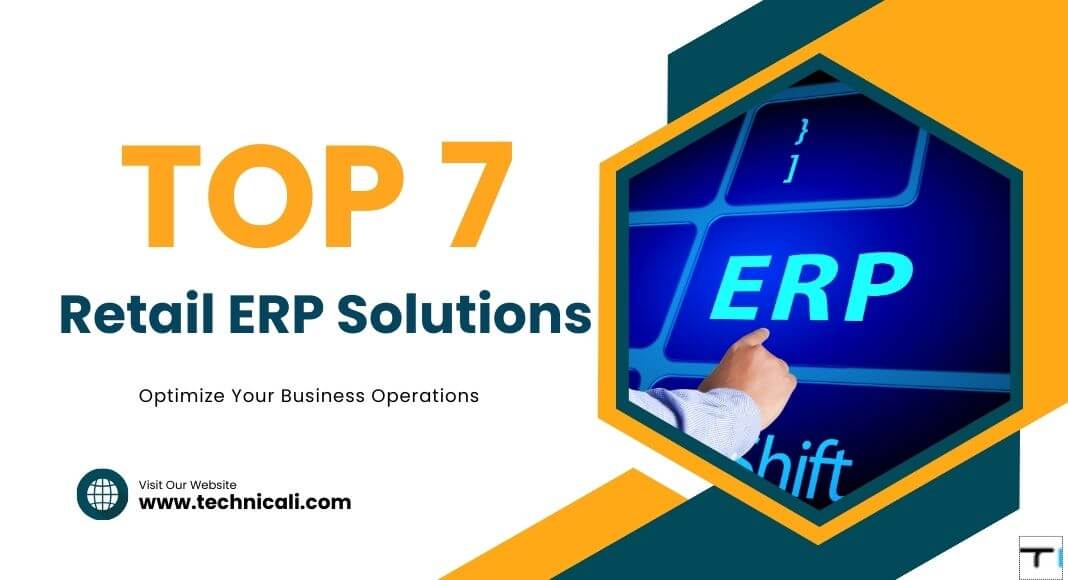Retail has become a complex environment in which seamless inventory management, integrated point of sale, and continuous customer experiences all converge. Yet, numerous businesses struggle with maintaining multiple systems that cannot consolidate data successfully. This is where an ERP system designed specifically for retailers is helpful. With the selection of a retail ERP, you bring yourself to the world of real-time insights, optimised operations, and a chance to capitalize on data-driven approaches in a competitive marketplace.
Contents
- 0.1 Introduction
- 0.2 What is a Retail ERP System
- 0.3 Key Features to Look for in a Retail ERP System
- 0.4 Top 7 Retail ERP Solutions for 2025
- 0.5 How to Choose the Best ERP for Your Retail Business
- 0.6 Common Challenges When Implementing a Retail ERP (And How to Overcome Them)
- 0.7 Future Trends in Retail ERP (2025 and Beyond)
- 1 Conclusion
Introduction
A strong ERP solution enables retailers to move beyond paper-based processes and eliminates operational friction. Whether you have a single store or numerous retail outlets, you require a platform that offers cloud-based integration and improved management tools and drives your retail business toward long-term growth. Traditional methods often create siloed data, complicating supply chain transparency and stifling efficient operations. A well-chosen solution eliminates these hurdles and positions your company to thrive in an era where customer expectations, online shopping, and omnichannel experiences are top priorities.
What is a Retail ERP System
A retail ERP system is an application that brings together sales, inventory, supply chain, financial, and customer information into a single platform. This unification eliminates fragmentation and provides one source of truth to let everyone on your staff work with the same information. It provides retailers with omnichannel capabilities that enable them to connect physical and digital touchpoints, simplifying the shopping experience.
Why Traditional ERP Systems Fail in Retail
Most of the traditional ERP solutions are on-premises and are not able to handle the dynamic aspects of the retail business. There’s little or no POS integration or poor e-commerce alignment in many of these traditional ERP solutions, resulting in inefficient inventory management and lost sales. Legacy solutions also have complex licensing costs, which are concealed, making them less desirable for retailers who require flexibility and clarity of cost structure.
Key Features to Look for in a Retail ERP System
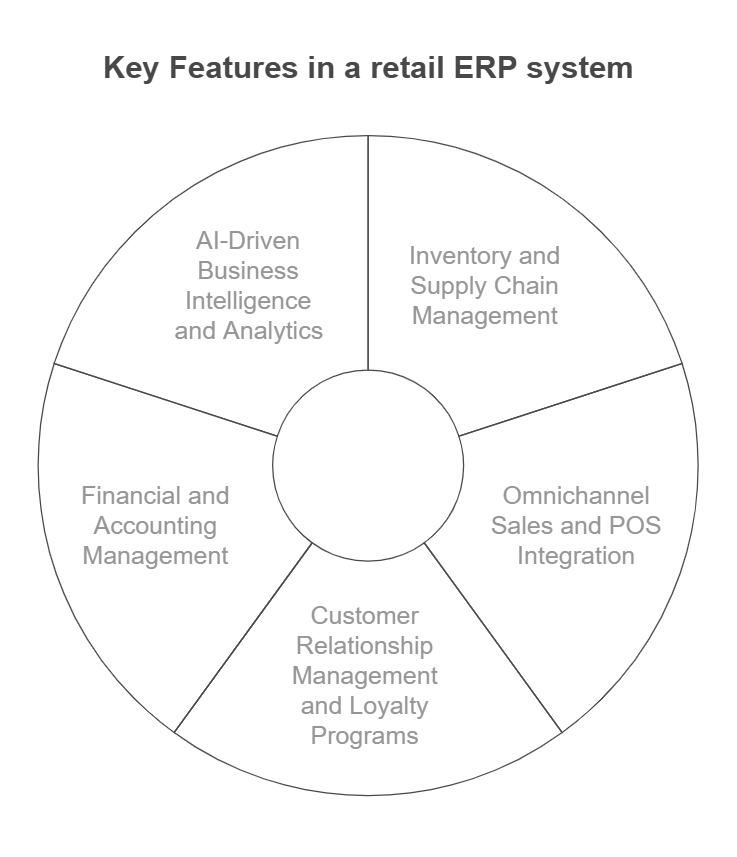
1. Inventory and Supply Chain Management
One vital aspect of an ERP for retail is the ability to handle accurate inventory management across multiple locations. Look for a platform that supports automated stock replenishment and forecasting. Effective supply chain management relies on centralized data that helps retailers react swiftly to shifts in demand. A well-chosen solution can consolidate the pieces of software you currently use into one software system, reducing confusion and waste.
2. Omnichannel Sales and POS Integration
Omnichannel retail is not a choice. An ERP solution that is not integrated with prominent e-commerce sites could be a growth stopper. A point-of-sale-supporting retail ERP solution aligns in-store and online channels to create a cohesive customer experience that can boost revenue by a wide margin. Integration also provides a better picture of each customer’s purchasing behavior.
3. Customer Relationship Management and Loyalty Programs
Retailers that utilize CRM capability within their ERP reap significant advantages of retail ERP. The power to monitor customer behavior, personalize automated promotions, and measure campaigns in real-time optimises the retail customer experience. This process not only increases loyalty but also enables customer segmentation for targeted marketing, maximizing your management software.
4. Financial and Accounting Management
Order management, tax compliance, and connectivity to well-known accounting programs such as QuickBooks are vital to any retail business. A financial transparency-designed retail ERP system can integrate various processes under one system, which can save both resources and time. It also makes auditing simpler and decreases errors caused by flipping back and forth between independent software systems.
5. AI-Driven Business Intelligence and Analytics
Most of the new ERP systems leverage artificial intelligence to provide predictive analytics. From predicting sales patterns to informing strategic decisions, AI assists retailers in optimizing product mixes and advertising campaigns. Through real-time measurements in a master dashboard, managers have instant visibility into key performance metrics.
Top 7 Retail ERP Solutions for 2025
1. NetSuite for Retail
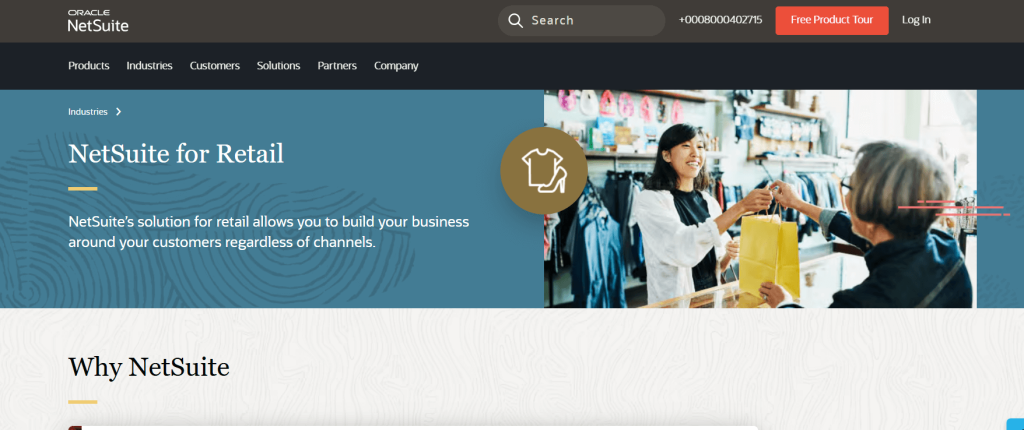
NetSuite for retail is a comprehensive software solution that excels in unifying multichannel data for businesses that demand scalability. This cloud-based ERP software stands out for its robust inventory features and expansive reporting tools.
Key Feature
- Real-time visibility of inventory across all retail stores
- Automated order management and supply chain management
- Integrated CRM for personalized campaigns
- Cloud ERP system with strong e-commerce integration
- Advanced dashboards for data-driven analysis
Assets
- Seamless retail management
- Highly customizable modules
- Strong global support
- Trusted by diverse retailer segments
- Frequent updates ensure cutting-edge capabilities
Liabilities
- Higher price point for a small retail business
- Requires specialized training
- Initial setup complexity can be steep
- Heavily reliant on a stable internet connection
- Some advanced features need additional licensing
2. Epicor Prophet 21
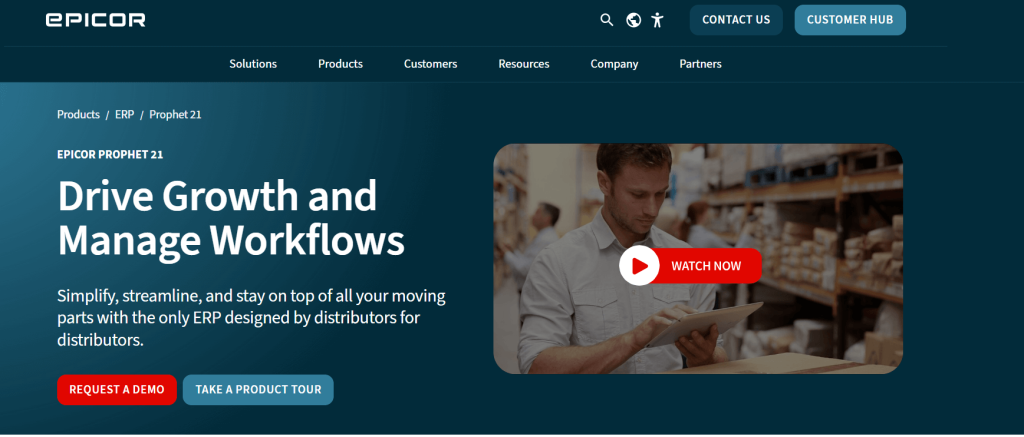
Epicor Prophet 21 is a solution that addresses multi-store requirements and integrates POS with core financial modules. Designed for retail industry growth, this new ERP brings flexibility to rapidly changing consumer demands.
Key Feature
- Role-based dashboards with real-time data
- Focused on omnichannel retail integration
- Automated order processing and inventory management
- Industry-specific customisation options
- Ability to unify distribution workflows
Assets
- Tailored for retailers and distributors
- Offers advanced integration with third-party apps
- Easy to configure reporting tools
- Cloud solution or on-premise deployment
- Scalable for expanding retailer footprints
Liabilities
- A traditional ERP setup can be time-consuming
- Some modules require external add-ons
- Occasional complexity in the user interface
- Relatively high upfront investment
- Limited self-service knowledge base
3. SYSPRO ERP
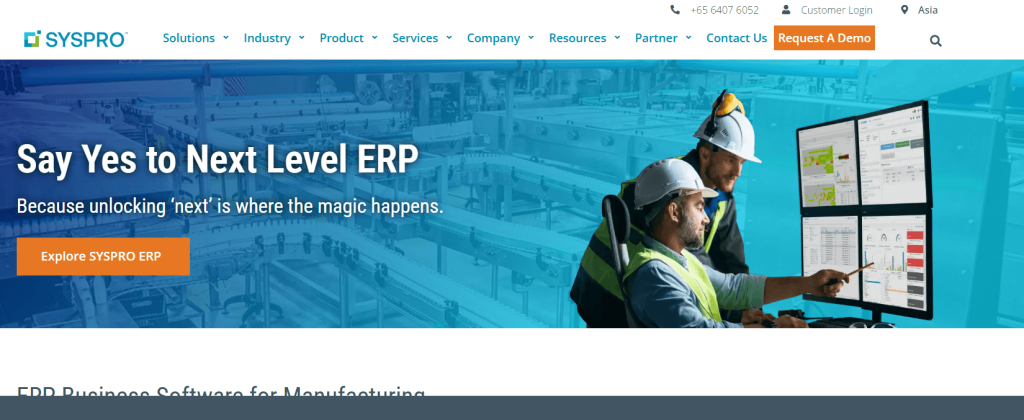
SYSPRO ERP focuses on manufacturing and distribution but has carved a niche for retailers needing a holistic view of operations. It melds order management with deep analytics and can help design efficient workflows.
Key Feature
- Comprehensive inventory oversight
- Real-time tracking for multi-store operations
- Hybrid deployment (cloud-based or on-premise)
- Management system with robust reporting
- Workflow automation and alerts
Assets
- Efficient workflow designs
- Adaptable to various retail environments
- Tightly integrated financial planning
- Detailed supply chain analytics
- Active user community for support
Liabilities
- User experience can feel outdated
- Requires technical expertise for customisations
- Potential need for third-party CRM integration
- Longer implementation timelines
- Ongoing maintenance can be costly
4. SAP S/4HANA Retail
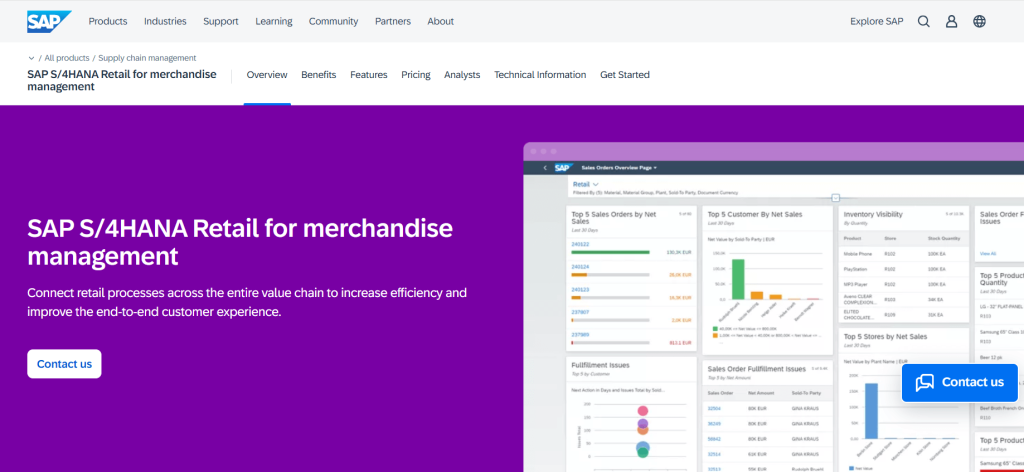
SAP S/4HANA Retail is an enterprise resource planning system engineered for large-scale retailers seeking real-time operational insights. It leverages an in-memory database for rapid data processing, helping businesses optimise inventory, enhance customer experiences, and streamline supply chain processes. With global support and integration capabilities, this ERP solution aims to consolidate finance, logistics, and omnichannel retail data in a single, unified platform.
Key Features
- Real-time analytics powered by the SAP HANA in-memory database
- AI-driven demand forecasting and predictive modeling for inventory management
- Integrated POS and CRM systems for an omnichannel retail experience
- Comprehensive supply chain visibility from production to customer
- Flexible deployment options, including on-premise, cloud, and hybrid
Assets
- Rapid data processing across multiple retail channels
- Highly customizable modules and workflows
- Strong global support with a vast partner network
- Deep integration with other SAP offerings
- Enterprise-level security and compliance features
Liabilities
- High initial investment and licensing costs
- A complex implementation that may require specialized consulting
- It can be more robust than necessary for smaller operations
- The steep learning curve for new users
- Additional fees for certain advanced analytics modules
5. Acumatica Retail ERP
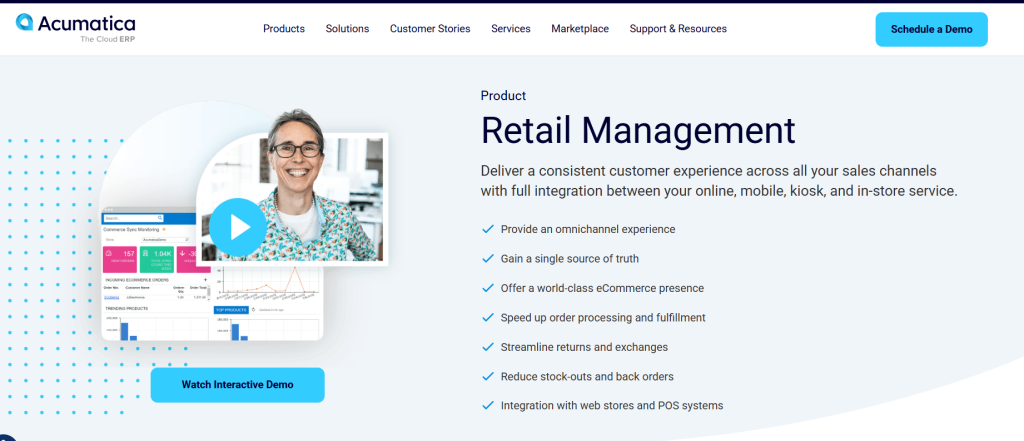
Acumatica retail focuses on end-to-end visibility, from order placement to fulfillment, with a cloud-based design that accommodates multi-store setups. It’s particularly attractive for growing retailers seeking cost-effective solutions.
Key Feature
- Unified commerce approach aligning online and offline channels
- Real-time order tracking with robust integration
- Built-in analytics for retail operations
- ERP features for easy custom reporting
- Flexible pricing tiers for retailers of varying sizes
Assets
- Straightforward interface
- Budget-friendly cloud-based ERP software
- Strong partner ecosystem
- Transparent licensing model
- Quick to scale based on business needs
Liabilities
- Less brand recognition among older providers
- Smaller user community for peer-to-peer support
- Certain specialized features may require add-ons
- Some advanced configurations demand expert assistance
- Can face integration hurdles with legacy ERP software
6. Odoo ERP for Retail
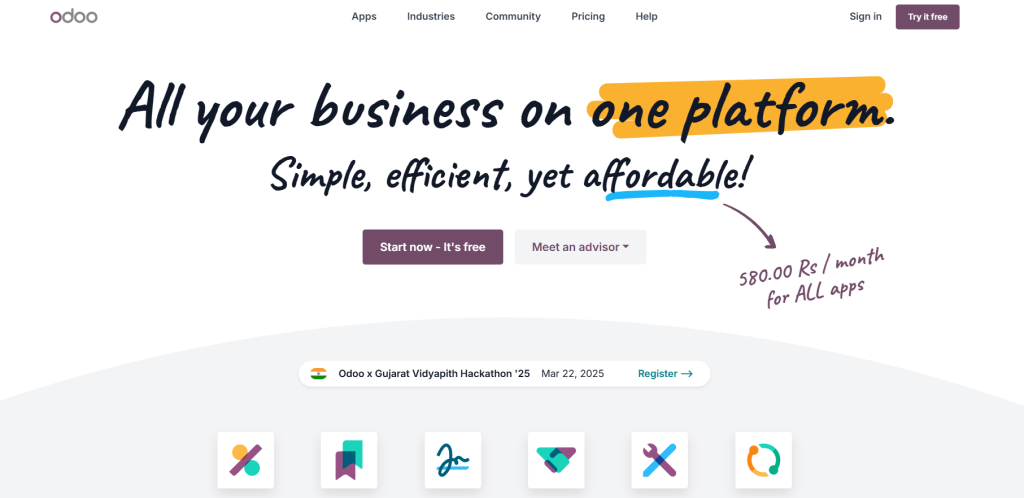
Odoo ERP for retail is an open-source platform that offers substantial flexibility at a lower cost. It wraps up essential functions like CRM, inventory, and accounting under one retail ERP package, making it a versatile choice.
Key Feature
- Modular design allows quick feature additions
- Retail ERP software that supports multi-store expansions
- Built-in point of sale to unify retail storefront experiences
- Community and enterprise editions are available
- Cloud-based or on-premises deployment
Assets
- Low entry cost
- Vibrant open-source community
- Ready-made integrations for e-commerce
- Easy to develop custom modules
- Straightforward user interface
Liabilities
- Needs some technical know-how for installation
- Documentation can be dispersed
- Community modules vary in quality
- It may be missing strong features of high-end solutions
- Upgrades may produce module compatibility issues
7. Lightspeed Retail ERP
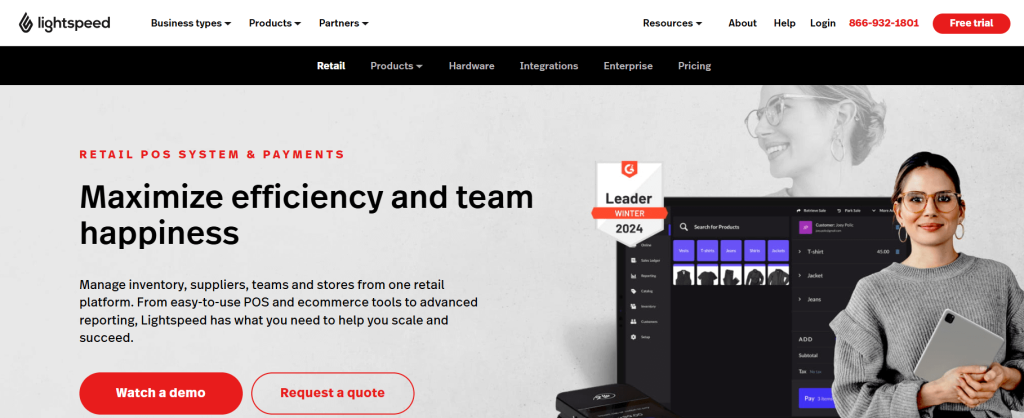
Lightspeed Retail ERP is recognized for its sleek interface and specialized POS solutions that benefit modern retailers. Its commerce-centric features help businesses merge online, in-store, and mobile sales channels into one coherent system.
Key Feature
- Sophisticated POS that includes loyalty programs
- Inventory tracking across multiple locations
- Integrated data analytics for retail store performance
- Easy integration with common e-commerce platforms
- Cloud-based framework for anywhere, anytime access
Assets
- Intuitive design for store associates
- Highly regarded user support
- Built-in tools for marketing campaigns
- Strong multichannel alignment
- Rapid deployment for new store locations
Liabilities
- Focusing on small and midsize retailers can limit big enterprise usage
- Certain advanced reporting features may cost extra
- Less suitable for large-scale supply chain complexities
- Fewer global support resources than some bigger providers
- Recurring subscription costs can add up
How to Choose the Best ERP for Your Retail Business
1. Define Your Business Needs
Before signing up for any ERP platform, define your particular retail business requirements. Do you require multi-store inventory tracking or perhaps advanced CRM features for focused promotions? Do AI-based forecasting and powerful analytics matter?
2. Compare Cloud vs On-Premise ERP
Cloud-based ERPs provide remote access, updates on the fly, and easy deployment, while traditional ERPs may allow for on-premises control. Compare the advantages of each option with your budget and the technical capabilities of your team.
3. Evaluate Total Cost of Ownership (TCO)
Be mindful of software licensing fees, maintenance, and potential hardware investments. Some providers break down these costs clearly, whereas others might merge them into bundle pricing. Evaluate potential hidden expenses, including training.
4. Check for Scalability and Integration
Your chosen retail ERP solution should accommodate growth. Look for systems that integrate with your existing POS, CRM, and e-commerce solutions. Failure to plan for integration can limit long-term expansion and reduce overall return on investment.
Common Challenges When Implementing a Retail ERP (And How to Overcome Them)

1. High Initial Costs
For smaller stores or those with tighter budgets, choosing an ERP for small businesses can balance large capital investments. Some providers have monthly subscription plans that lower initial costs.
2. Staff Resistance to New Technology
Staff training is essential. Offer workshops, user manuals, and management options that make adoption easy. Quick wins, such as quicker point-of-sale operations or more efficient inventory management, make staff realize the value of the ERP.
3. Downtime and Data Migration Risks
Data migration to a new ERP might appear daunting. To mitigate this risk, migrate in stages and test each phase thoroughly. Frequent data backups and proper planning ensure minimal downtime.
Future Trends in Retail ERP (2025 and Beyond)
1. AI and Machine Learning for Predictive Analytics
ERP systems are designed to harness machine learning to forecast demand, optimise inventory, and personalize customer experiences. Retailers harness this technology to stay competitive in a market driven by rapid consumer shifts.
2. Blockchain for Transparent Supply Chain Management
Blockchain functionality facilitates easier tracking of products from the supplier to the retailer. When paired with appropriate ERP software tailored for transparency, retailers can guarantee customers regarding product authenticity and ethical sourcing.
3. ERP-Powered Hyper-Personalisation in Retail
Hyper-personalisation, driven by real-time data, can enhance customer loyalty and drive repeat business. ERP makes it easier to track preferences, deliver tailored offers, and unify marketing campaigns, creating a memorable customer journey.
Conclusion

Selecting the optimal ERP for retail processes is a key decision that has an impact on how well you process orders, integrate online and offline sales, and adapt to market changes. By assessing your business requirements, contrasting deployment styles, and choosing a platform that grows with the expansion of your business, you can implement a retail ERP solution that increases productivity and puts you ahead of competitors. Emerging trends like AI and blockchain point to a future of deeper analytics and more transparent supply chains, reinforcing why an adaptable and forward-looking retail ERP solution is vital. Whether you operate a local retail store or manage a multi-store chain, investing in the right ERP can transform challenges into opportunities and set the stage for long-term success.

